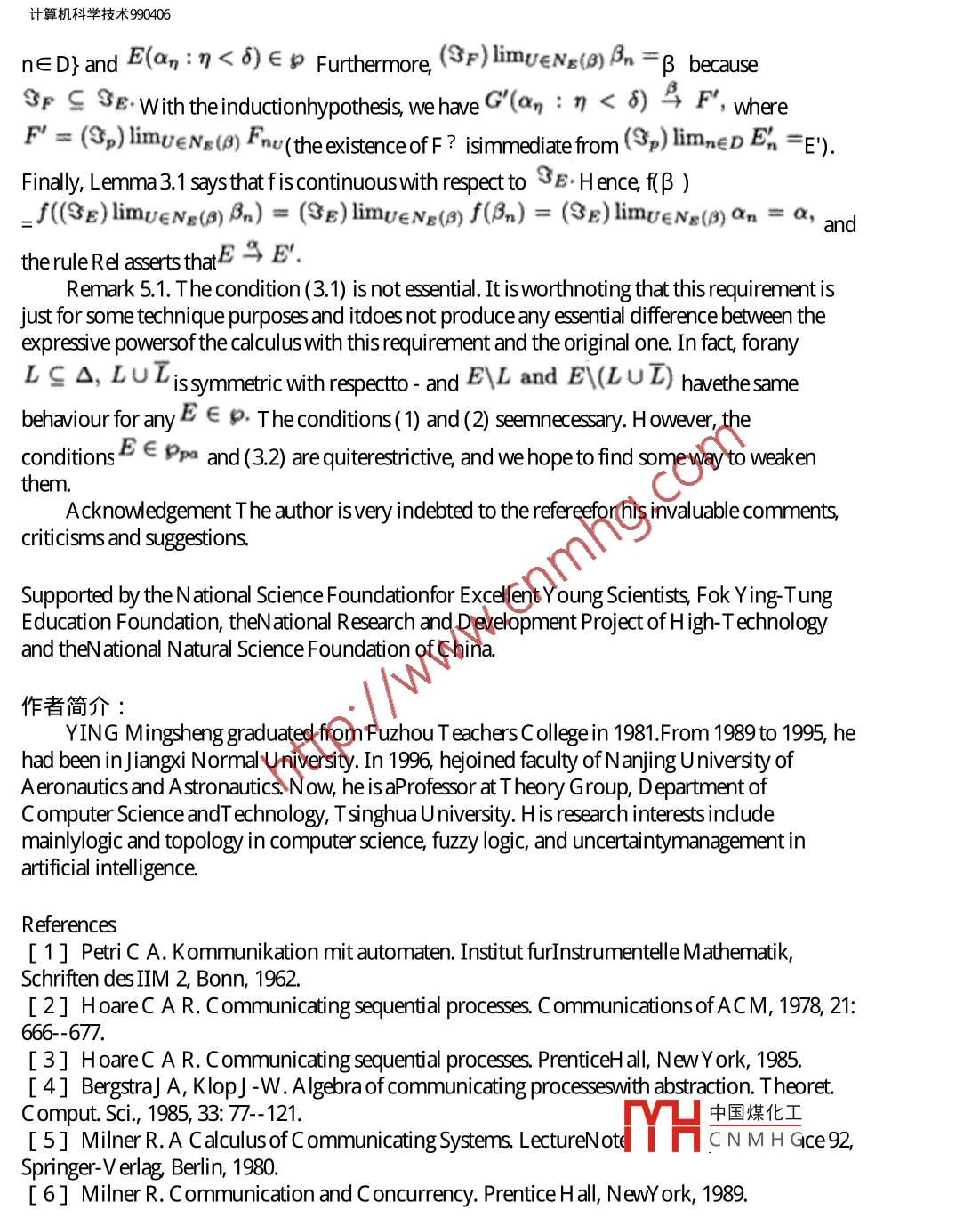

Topology in Process Calculus (I): Limit Behaviour of Agents
- 期刊名字:计算机科学技术学报(英文版)
- 文件大小:525kb
- 论文作者:YING Mingsheng
- 作者单位:Department of Computer Science and Technology
- 更新时间:2020-11-10
- 下载次数:次
计算机科学技术990406计算机科学技术R资源系统JOURNAL OF COMPUTER SCIENCE数字化期刊WANFANG DATA ( CHINAINFO)AND TECHNOLGYDIGITIZED PE RIODICAL1999年第14卷第4期V ol.14 No.41999T opology in Process C alculus(I):Limit Behaviour of AgentsYING Mingsheng(应明生)Department of C omputer Science and T echnology, TsinghuaUniversityBejing 100084, P.R. ChinaAbstract This paper introduces the modifications onactions of a topology on names ofactions and thesimplest topology onagents induced by a topology on names of actions andshows that the limitbehaviour of some agents is compatible with transitional semantics.Key words process calculus, transitional semantics,topology, limit behaviour1 IntroductionC ommunication and concurency are essential in understandingcomplex dynamic systems,and there have been many theories to deal with,such as Petri nets[1], CSP [23] and ACP[4].CCSproposed by R. Milnerin [ 5, 6] or process calculus as calledin[ 6] isoneof themost important and mathematially developed models ofcommunication and concurrency. Inprocess calculus, a central notion isobservation equivalencewhich expresses the equivalenceofprocesseswhose external communications follow the same pattern but whose internalbehaviourmay differ widely. W e know that both external and internalbehaviours in a process consist ofsome basic actions, and these basicactions are supposed to be distinct and irrelativewith eachother. Insome realistic situations, however, we may find that some actions arequite similar butothers are not. To be more explicit, let us consideran example. Suppose that three vendingmachinesC, F and S forselling C oCa-C ola, Fanta and soap, respectively, are defined as follows:C“e 1.cacaCalacoletC,F ≌ldanacollet.F. andS ae 1d.ap.olletsThis means, for example, that to buy a cup of Fanta from the machine Fyou must put in onedollar, press the button marked Fanta' on themachine F, and collect your Fanta from the tray. Ifsome person isextremely thirsly and wants to buy a cup ofC 0caC ola, and there is notthemachine C but the machines F and S nearby, then it isreasonable to expect that this person willbuy a cup of Fanta from Fbut not a cake of soap fromS. As asecond example, wesupposeothertwo vending machinesC+ and C- areall for selling C oCaC olabut the prices are different.Furthermore, we suppose that C+ andC- are defined byC+ eg! 1.5d.Coca-Colacollect.C+, andC-“些 0.8d.Coca中国煤化工MHCNMHGrespectively. If some person just wants to buy a cup ofC 0ca-C olawnich COSTS aoout 80cents, and there is not the machineC- but themachinesC and C+ nearby, then it isfle:/// vqkj-/sig9/sik994/90406.htm(第1/ 15页) 2010-3-23 1:12:03计算机科学技术990406alsoreasonable to expect that this person will buy acup of C oca C olacosting one dollar fromCbut not acup of C 0caC ola costing onedollar and 50 cents fromC+. Why? An intuitive answermay be thatF is moresimilar to C than S, and C is moresimilar to C -than C+. H owever, it isclearthat this cannot be explainedformally in the process calculusin [ 5, 6] . To this end, we shouldaddsome topological structure on agent expressions. For example, we definea metric ρ 1 withρ 1(Coca-Cola, Fanta)=1,ρ 1(Coca-Cola, soap)=ρ 1(Fanta, soap)=+∞and ametricp 2with ρ 2(0.8d, 1d)=0.2, ρ 2(0.8d, 1.5d)=0.7 andp 2(1d, 1.5d)=0.5.Ifρ 1 and ρ 2 can induce somemetricp on agent expressionssuchthat, say,ρ (C,F)=1,ρ (C,S)=ρ (F,S)=+∞,ρ (C,C)=0.2,ρ (C-,C+)=0.7andρ (C,C+)=0.5, thenρ (C,F)<ρ (C,S)andρ (C-,C)<ρ (C-,C+),and this will be a quitenatural mathematical answer to the above question.Asa formalization of the simple idea mentioned above, the main aim ofthis paper and itscontinuations is to construct some natural topologieson agent expressions from each giventopology on basic actions and showthat these topologies are compatiblewith some notions ofbehaviour ofagents and equality over the process calculus. In this paper, weintroduce theconcepts of modifications on actions of a topology onnames of actions and the simplest topologyon agents induced by atopology on names of actions and show that the limit behaviour ofsomeagents is compatiblewith transitional semantics.2 PreliminariesIn this paper, for simplicity and as the first step we onlyconsider the basic calculusofsynchronisationin [ 6] . H ere, we displaysome fundamental concepts in the way which can beusedconveniently forour purpose. For details, see [ 6] .2.1 Basic LanguageLetO beaset, whose elements aealled actionslet△= {征:a∈0}thessetof co- namesofactions, andletI = 0 U A, theset oflabels. In addition, Ietτ stand for thesilent action,andAct = ru {}, the set of actions. By defininga = a foranya∈△andF = T,- may beextended as a mapping from Act to itself. Afunction f:「→「is called a rlabellingiif() =两foreveryI∈「. Wemay extenda relabelling fto bea mapping fromAct to itself by definingf(τ )=τ .Furthermore, letθ∈On (the limitordinals), and let究be aset, whose elements are calledagentconstants. Weset8= RU{a.:a∈Act}U {2n<8:δ < o}∪{|}u{\L: L≤r}u {[f]:f sarlabeling andE<0 =∪8















-
C4烯烃制丙烯催化剂 2020-11-10
-
煤基聚乙醇酸技术进展 2020-11-10
-
生物质能的应用工程 2020-11-10
-
我国甲醇工业现状 2020-11-10
-
JB/T 11699-2013 高处作业吊篮安装、拆卸、使用技术规程 2020-11-10
-
石油化工设备腐蚀与防护参考书十本免费下载,绝版珍藏 2020-11-10
-
四喷嘴水煤浆气化炉工业应用情况简介 2020-11-10
-
Lurgi和ICI低压甲醇合成工艺比较 2020-11-10
-
甲醇制芳烃研究进展 2020-11-10
-
精甲醇及MTO级甲醇精馏工艺技术进展 2020-11-10

